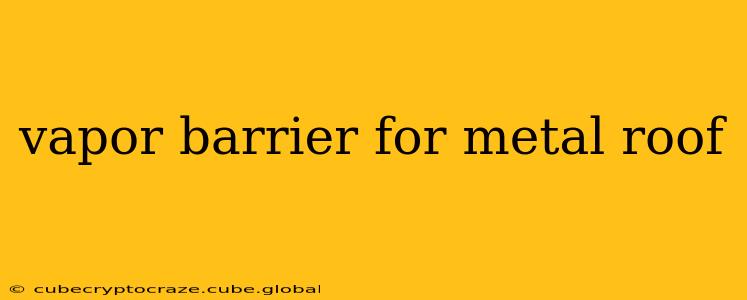Metal roofs are increasingly popular due to their durability, longevity, and aesthetic appeal. However, proper installation, including the use of a vapor barrier, is crucial to prevent costly problems down the line. This comprehensive guide will explore the importance of vapor barriers in metal roofing systems, addressing common questions and concerns.
What is a Vapor Barrier and Why is it Important for a Metal Roof?
A vapor barrier is a material designed to impede the flow of moisture vapor. In the context of a metal roof, it's a critical component that prevents water vapor from entering the attic space from inside the building. Without a proper vapor barrier, moisture can condense within the roof assembly, leading to mold growth, wood rot, insulation degradation, and structural damage. This is especially important with metal roofs because they are excellent reflectors of heat, potentially creating a significant temperature difference between the inside and outside of the building. This temperature difference drives moisture migration.
What are the Different Types of Vapor Barriers for Metal Roofs?
Several types of vapor barriers are suitable for use with metal roofs. The best choice depends on factors like climate, budget, and building codes. Common options include:
- Polyethylene films: These are relatively inexpensive and readily available. They offer good vapor resistance but can be susceptible to tearing.
- Polypropylene films: Stronger and more durable than polyethylene, these offer improved tear resistance and UV protection.
- Reflective foil-faced insulation: This combines insulation with a vapor barrier in a single product, offering both thermal and moisture protection. This can be particularly effective in hot climates.
- Housewrap (Tyvek): While not a primary vapor barrier, it can offer some protection and is often used in conjunction with other vapor barriers. It’s more effective at managing liquid water rather than vapor.
- Specialty membranes: Some manufacturers offer specialized membranes designed specifically for metal roofing systems. These often offer superior performance and durability.
Where Should the Vapor Barrier Be Installed in a Metal Roof System?
The placement of the vapor barrier is critical. It should be installed on the warm side of the insulation. In most climates, this means placing it directly beneath the insulation in the attic. This prevents moisture from condensing within the insulation itself. Incorrect placement can negate the effectiveness of the vapor barrier.
Do I Need a Vapor Barrier Under My Metal Roof?
The need for a vapor barrier depends largely on your climate. In humid or wet climates, a vapor barrier is almost always essential to prevent moisture-related problems. In drier climates, the need is less crucial, but it's still a good practice to ensure long-term protection of your roof and building. Consult local building codes and a qualified roofing professional for recommendations specific to your location.
How Much Does a Vapor Barrier Cost for a Metal Roof?
The cost varies depending on the type of vapor barrier chosen, the size of the roof, and labor costs. Polyethylene films are the most economical option, while specialized membranes tend to be more expensive. The cost of installation should also be factored into the overall budget.
How to Install a Vapor Barrier Under a Metal Roof?
Installing a vapor barrier requires careful attention to detail. Overlapping seams must be sealed properly to prevent moisture penetration. Taping and sealing are crucial steps to ensure the vapor barrier’s effectiveness. Consult professional roofing guides or a qualified contractor for detailed instructions appropriate for your specific situation and chosen material. Improper installation can render the barrier useless.
This guide provides a foundation for understanding the vital role of vapor barriers in metal roofing systems. Remember to always consult local building codes and seek professional advice for your specific project to ensure optimal performance and longevity of your metal roof. Proper installation of a vapor barrier is an investment that pays dividends in preventing costly repairs and maintaining the integrity of your building.
